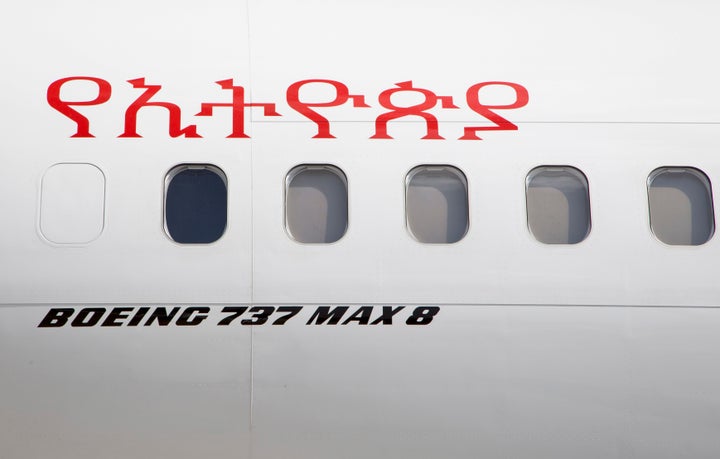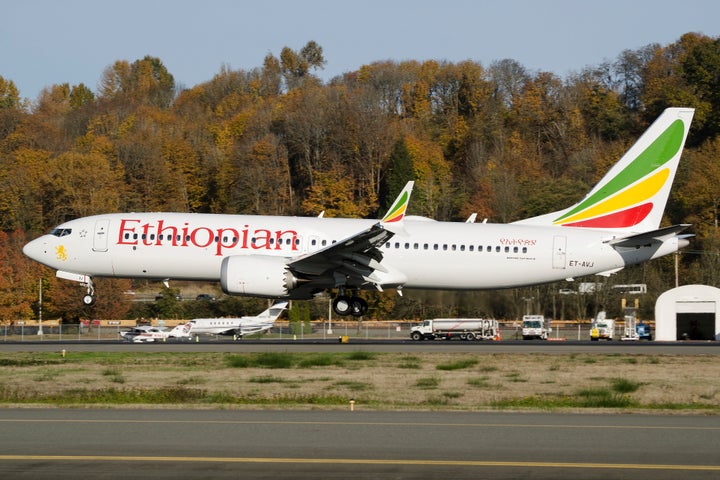Ethiopian investigators have offered the first official glimpse into what is known about the second of two fatal Boeing 737 Max 8 crashes over five months and how they are related.
The Ethiopian Accident Investigation Bureau released details from a preliminary report at a press conference Thursday, saying the findings suggest that the pilots of the doomed Ethiopian Airlines flight were not at fault. The final report may take a year to be completed, The New York Times reported.
After weeks of speculation and reported press leaks related to both 737 Max crashes ― the first involving a Lion Air flight in October ― a picture is starting to come together:

How did the pilots respond?
The pilots flying Ethiopian Airlines’ Boeing 737 Max 8 plane on March 10 fought to maintain control of the aircraft as it repeatedly nosedived just minutes after takeoff from Addis Ababa. The pilots’ efforts included following guidelines that had been recommended by Boeing and approved by the U.S. Federal Aviation Administration to handle such an emergency, Ethiopian authorities said.
“The crew performed all the procedures repeatedly provided by the manufacturer but was not able to control the aircraft,” Ethiopian Transport Minister Dagmawit Moges said at Thursday’s news conference, according to Reuters.
Ethiopian Airlines, in a statement on Twitter, praised the pilots’ “hard work and full compliance with the emergency procedures.”
“We are very proud of our pilots’ compliances to follow the emergency procedures and high level of professional performances in such extremely difficult situations,” said the airline’s CEO, Tewolde GebreMariam.
It was previously reported, based on simulation tests replicating the flight, that the pilots likely had less than a minute to disengage the plane’s automated anti-stall software, called the Maneuvering Characteristics Augmentation System (MCAS), to prevent it from nosediving to the ground after it received erroneous data suggesting that the aircraft was ascending at too steep of an angle.
During those final seconds, the pilots flipped through a technical manual in an attempt to understand what was happening, Reuters previously reported, citing cockpit voice recordings that had been reviewed by a source.
The pilots did appear to suspect that there was an issue with the automated software, however, as Moges said they turned the MCAS on and off.
“I can’t say how many times because we will find that out when we have the final report,” she told the Times.

What could have caused the plane to malfunction?
What may have caused the plane’s system to go haywire remains unclear.
ABC News, citing two aviation sources familiar with the crash investigation, reported that the plane’s MCAS had been damaged upon takeoff from a bird or other foreign object.
Amdye Andualem, chairman of the Ethiopian Accident Investigation Bureau, told reporters on Thursday that the plane’s data recorder did not indicate any damage from a foreign object, however.
Issues with the plane’s automated software also weren’t exclusive to the Ethiopian flight. Lion Air’s Boeing 737 Max 8 plane that crashed in Indonesia also experienced data problems in the days before.
That plane’s angle-of-attack sensor, which registers its angle of elevation and triggers the MCAS if the plane is deemed at risk of stalling, was ruled defective and replaced just days earlier after it experienced problems. But that replacement sensor may have also been defective, as it recorded a 20-degree difference in its measurements, the Times reported.

Pilots on at least two other Boeing 737 Max 8 flights also reported similar issues with the automated system, describing the plane as suddenly tilting down after they engaged the autopilot. In both cases, they recovered quickly after disconnecting the autopilot.
What now?
Ethiopia’s transport minister recommended that Boeing review the aircraft control system and that aviation authorities confirm any changes to it before allowing the plane, which was grounded globally last month, to resume flying.
Boeing, in a statement following Thursday’s press conference, said it will review the Ethiopian Accident Investigation Bureau’s preliminary report “and will take any and all additional steps necessary to enhance the safety of our aircraft.”
The aviation company also acknowledged that the report found similarities between the Ethiopian Airlines and Lion Air crashes, specifically with the angle-of-attack sensor.
Boeing previously announced that it had developed an MCAS software update for all of its planes that will provide additional layers of protection should its sensors receive erroneous data about the plane’s angle of attack. The company said it has been working to upgrade all of its planes with this new technology as well as install additional safety software that it previously charged extra for.
The FAA, responding to Ethiopian authorities’ news conference, said its investigation remains ongoing and that it will “take appropriate action” as findings become available.
